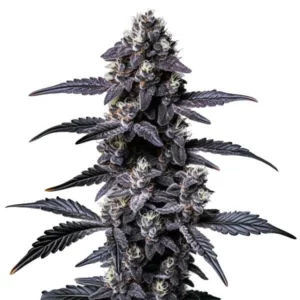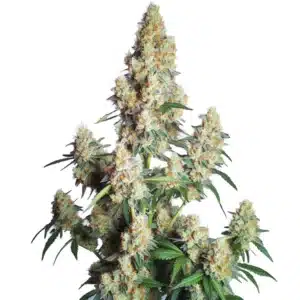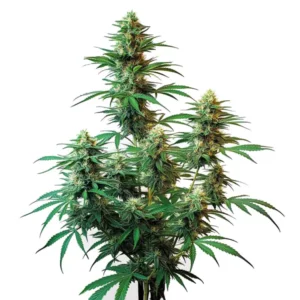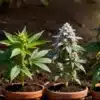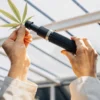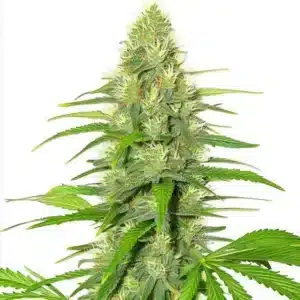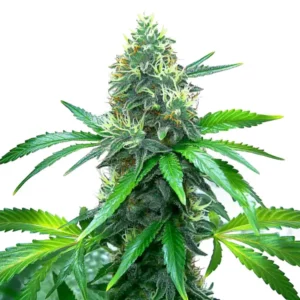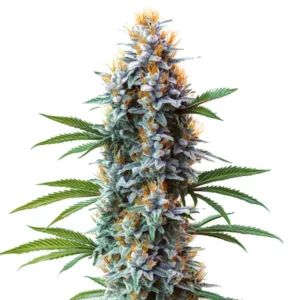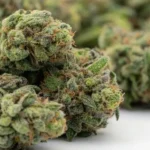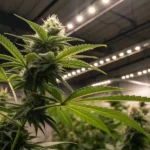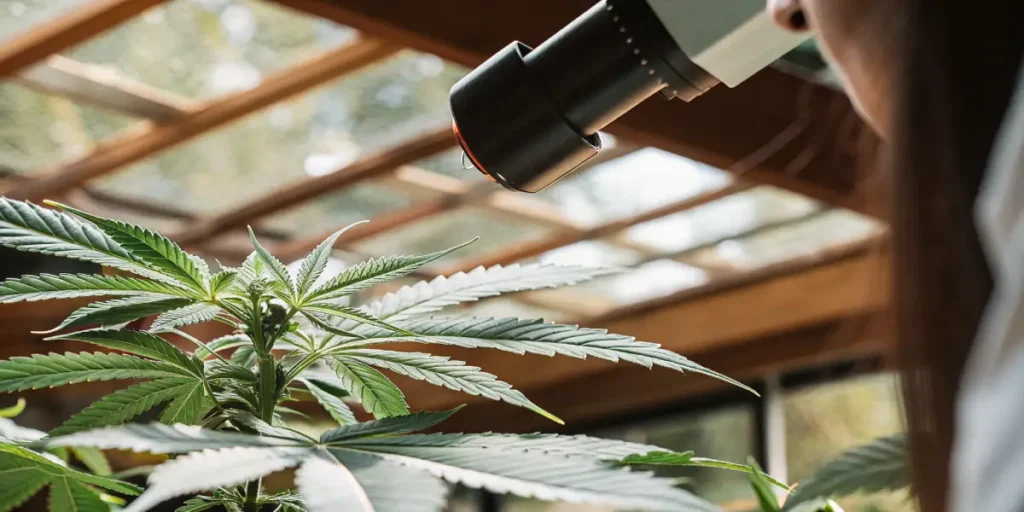
Laticifers vs. Trichomes Cannabis
When growing cannabis, both first-time seed buyers and seasoned cultivators encounter a fascinating duo: laticifers and trichomes. These two components play crucial roles in the cannabis plant, yet they are often misunderstood. Let’s delve into the laticifers vs. trichomes cannabis debate to unravel their differences and functions.
In cannabis plants, laticifers are specialized cells or ducts responsible for producing latex. This latex is a sticky, milky fluid that the plant exudes when damaged. On the other hand, trichomes are tiny, crystal-like structures covering the plant’s surface. They produce cannabinoids and terpenes, the compounds responsible for cannabis’s unique effects and aromas.
Recommended Strains
GG4
|
|
THC | 27% (High) |
|
|
Type | Feminized |
|
|
Yield | High |
|
|
Phenotype | 40% Indica / 60% Sativa |
Blue Dream
|
|
THC | 17% - 24% (Medium) |
|
|
Type | Feminized |
|
|
Yield | High |
|
|
Phenotype | 50% Indica / 50% Sativa |
Comparing cannabis laticifers and trichomes, it becomes apparent that both have distinct roles. While laticifers act as a defense mechanism, trichomes are more about protection and attraction. These small yet mighty structures contribute to the plant’s overall health and potency, making them essential in cannabis cultivation.
Differences Between Laticifers and Trichomes
When discussing laticifers and trichomes differences in cannabis, it’s essential to understand their unique functions. Laticifers are primarily involved in defense. They produce latex, which can deter herbivores due to its sticky and sometimes toxic nature. This latex may also help seal wounds, preventing infections.
Trichomes, in contrast, have a broader range of functions. They protect the plant from ultraviolet rays, reduce water loss, and deter pests. More importantly for growers, trichomes are cannabinoid factories. They produce THC, CBD, and a host of other cannabinoids, which are crucial for the plant’s psychoactive and medicinal properties.
The function of laticifers vs trichomes in cannabis plants is further emphasized in their contribution to plant resilience and vigor. While trichomes enhance the plant’s ability to withstand environmental stressors by producing a protective layer of resin, laticifers provide an internal shield through their latex production, safeguarding internal tissues from external threats. This dynamic duo ensures that the cannabis plant thrives even in challenging conditions.
Moreover, the cannabis plant laticifers versus trichomes function differently in response to environmental stimuli. Laticifers react primarily to physical damage, quickly exuding latex to seal off injuries, whereas trichomes are more responsive to light and temperature changes, adjusting their production of cannabinoids accordingly to optimize the plant’s survival and reproductive success. This adaptability showcases the intricate balance within the plant, highlighting the importance of both components in its lifecycle.
Promos & Deals
Cultivation Insights: Trichomes vs Laticifers
In cannabis cultivation, trichomes vs laticifers present different challenges and opportunities. Trichomes are often a primary focus for growers because they directly affect the plant’s potency. Harvest timing is crucial, as trichomes change color and clarity as they mature. This can indicate when the plant has reached its peak potency.
For example, strains like Gorilla Glue #4 are known for their dense trichome production, resulting in high THC levels. Monitoring trichomes closely can help growers decide the perfect harvest time for maximum effect.
On the other hand, laticifers require less attention during the cultivation process. While they play a vital role in the plant’s defense, growers don’t typically focus on them unless there’s damage to the plant that needs addressing. Knowing the function of laticifers vs trichomes in cannabis plants can guide growers in optimizing their cultivation practices.
Furthermore, the dynamic of trichomes vs laticifers in cannabis cultivation reflects a balance between maximizing yield and maintaining plant health. While trichomes are meticulously monitored for their cannabinoid content, laticifers serve as a passive safeguard, ensuring that the plant’s physical integrity is preserved against unforeseen threats. This holistic approach to cultivation underscores the necessity of both components for a successful harvest.
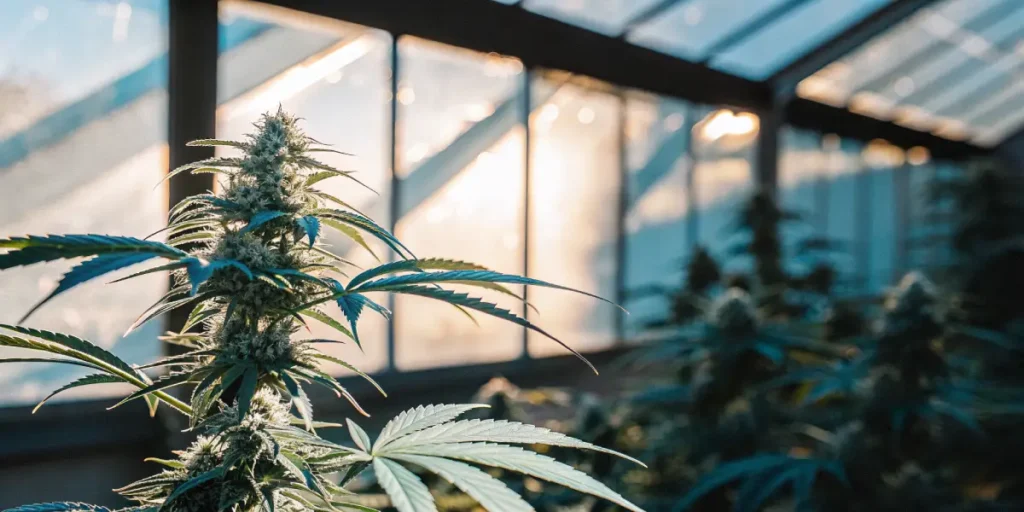
Real-Life Examples of Laticifers and Trichomes
Consider a grower cultivating a strain like Blue Dream. This strain is famous for its sweet aroma and balanced effects, thanks to its rich terpene profile. The trichomes on Blue Dream are responsible for this signature scent and potency.
In a scenario where a pest attack occurs, the plant’s laticifers might produce latex to ward off the invaders. While this isn’t something the grower actively manages, it’s a natural defense that can save the plant from severe damage.
Another example is White Widow. Known for its resinous buds, this strain’s trichomes are a primary focus for growers seeking high THC content. By monitoring trichome development, growers can maximize the strain’s potential, ensuring a powerful end product.
These examples illustrate the importance of comparing cannabis laticifers and trichomes in practical scenarios. While trichomes contribute directly to the plant’s market value through cannabinoid production, laticifers play a less visible but crucial role in ensuring the plant remains unscathed during its growth cycle. This complementary relationship highlights the need for growers to appreciate both elements in their cultivation strategies.
Moreover, knowing how different strains exhibit varying characteristics of laticifers and trichomes can inform breeding programs. Selecting for enhanced trichome production while maintaining robust laticifer function can result in plants that are not only potent but also resilient. This dual focus can lead to the development of superior cannabis strains that excel in both quality and durability.
Practical Tips for Managing Trichomes and Laticifers
- Use a magnifying glass or microscope to monitor trichome development. Look for a change from clear to milky white, indicating peak potency.
- Ensure plants are healthy and stress-free to promote optimal trichome production. Stress can decrease trichome density.
- In case of physical damage, allow the plant’s laticifers to work naturally. Avoid further harm to enable natural healing.
- Choose strains with known high trichome production for higher potency. Strains like Gorilla Glue #4 and White Widow are excellent choices.
- Maintain proper humidity and temperature to support both trichome and laticifer function, ensuring plant health.
To further enhance the effectiveness of laticifers vs. trichomes cannabis practices, consider integrating natural pest control methods. Encouraging beneficial insects or using organic sprays can reduce the need for chemical interventions, allowing laticifers to function optimally. This natural approach not only preserves plant health but also promotes a sustainable cultivation environment.
Additionally, employing techniques such as low-stress training (LST) can maximize light exposure to the plant, thereby enhancing trichome production without compromising the function of laticifers. By carefully bending and tying branches, growers can achieve an even canopy, leading to improved resin development and a more balanced plant structure.
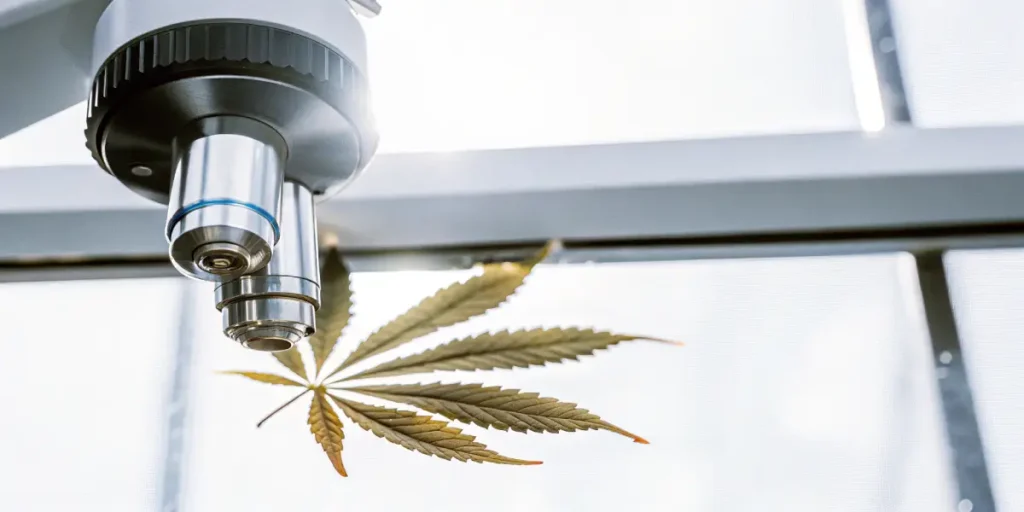
FAQs About Laticifers vs. Trichomes Cannabis
What are the main differences between laticifers and trichomes in cannabis?
The main differences between laticifers and trichomes in cannabis lie in their functions and appearances. Laticifers produce latex, a protective fluid that deters herbivores and seals plant wounds. This sticky substance is not directly involved in the plant’s psychoactive properties but plays a crucial role in its defense system.
Trichomes, however, are the glands responsible for cannabinoid production. These tiny structures look like crystals on the plant’s surface. They produce THC, CBD, and terpenes, which contribute to the plant’s aroma, flavor, and effects. Trichomes are a primary focus for growers looking to maximize potency and yield.
Knowing laticifers and trichomes differences in cannabis is key to optimizing plant health and production. Laticifers act as the plant’s first line of defense, ensuring its survival against external threats, while trichomes enhance its marketability through cannabinoid production. This dual function underscores the significance of both structures in the plant’s overall lifecycle.
Furthermore, the interplay between the two components affects the plant’s ecological interactions. While laticifers provide a deterrent against herbivores, trichomes attract pollinators and beneficial organisms through their aromatic compounds. This balance between deterrence and attraction is a testament to the evolutionary success of cannabis plants in diverse environments.
How do trichomes affect the quality of cannabis?
Trichomes directly impact the quality of cannabis by producing cannabinoids and terpenes. These compounds are responsible for the plant’s effects, whether it’s the psychoactive high from THC or the calming effects of CBD. A higher concentration of trichomes usually means a more potent product.
Growers often monitor trichome development closely. The color and clarity of trichomes can indicate the ideal harvest time. For instance, milky white trichomes suggest peak potency, while amber trichomes might indicate a more sedative effect. This attention to trichome detail ensures that the final product meets desired quality standards.
In the context of laticifers vs. trichomes cannabis cultivation, trichomes are the primary focus for enhancing product quality. By optimizing conditions for trichome development, growers can significantly boost the plant’s cannabinoid profile, resulting in a superior end product. This focus on trichomes also aligns with market demands for high-potency cannabis.
Additionally, the presence of robust trichomes can enhance the plant’s resistance to environmental stressors. The resin produced by trichomes acts as a natural barrier against pests and harsh weather, thereby indirectly supporting the function of laticifers in safeguarding the plant’s health. Together, these components ensure a resilient and high-quality cannabis crop.
Can I increase trichome production in my cannabis plants?
Yes, increasing trichome production is possible with the right techniques. Start with selecting strains known for dense trichome production, such as Gorilla Glue #4 or White Widow. These strains have genetics that favor high trichome output.
Environmental factors also play a role. Maintain optimal humidity and temperature levels, and ensure your plants are stress-free. Nutrient management and proper lighting can also enhance trichome production, resulting in a more potent and aromatic harvest.
Moreover, integrating advanced cultivation techniques can further amplify trichome production. Methods such as topping and defoliation can promote increased light penetration and airflow, stimulating trichome development. These practices, when applied correctly, can enhance the overall yield and quality of the cannabis crop.
In the context of trichomes vs laticifers in cannabis cultivation, focusing on trichome enhancement does not negate the importance of laticifers. Instead, maintaining a balanced approach that considers both components can lead to a healthier and more productive plant. This comprehensive strategy ensures that the plant’s defensive and productive mechanisms are both optimized.
Do laticifers have any impact on cannabis potency?
Laticifers do not directly impact cannabis potency. Their main function is to produce latex, which acts as a defense mechanism against pests and physical damage. While they play a vital role in the plant’s overall health, they do not contribute to cannabinoid or terpene production.
However, healthy laticifers can indirectly support potency by keeping the plant safe from harm. By protecting the plant from pests and infections, laticifers ensure that the plant can focus its energy on producing trichomes and developing cannabinoids, leading to a successful harvest.
While laticifers are not involved in cannabinoid synthesis, their role in preserving plant health is crucial. By mitigating damage and infection, laticifers allow the plant to allocate more resources towards trichome production, indirectly impacting the plant’s potency and overall yield. This protective function is an essential aspect of the plant’s lifecycle.
In the broader discussion of cannabis plant laticifers versus trichomes function, it’s important to recognize the complementary nature of these components. While laticifers provide a physical safeguard, trichomes contribute to the plant’s chemical defense. Together, they create a robust system that supports both plant survival and quality production.
Why are trichomes more important than laticifers for growers?
Trichomes are more important than laticifers for growers because they are directly responsible for producing the compounds that give cannabis its effects. Cannabinoids and terpenes, produced by trichomes, determine the plant’s potency, flavor, and aroma, which are critical factors for both recreational and medicinal users.
While laticifers play a crucial role in plant defense, they do not influence the psychoactive or therapeutic properties of cannabis. Growers focus on maximizing trichome production to enhance the quality and value of their harvest, making trichomes a more significant concern in cannabis cultivation.
The emphasis on trichomes vs laticifers in cannabis cultivation stems from market demands. As consumers seek products with specific cannabinoid profiles, growers prioritize trichomes to meet these expectations. This focus ensures that the final product not only meets quality standards but also aligns with consumer preferences for potency and efficacy.
Nonetheless, it is important for growers to maintain a holistic approach that acknowledges the function of laticifers. By ensuring that both trichomes and laticifers function optimally, growers can cultivate plants that are not only potent but also resilient, leading to a more reliable and successful harvest.




